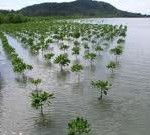Mangrove protection and restoration could be an economic way of mitigating greenhouse gases to curb global warming, research suggests.
Mangroves are now looked after by scientists as saviors in the today’s scenario of global warming.
Similar to rainforests, they store carbon within their ‘biomass’, which is released when the habitat is destroyed.
Their ability to capture carbon may be on average five times that of tropical rainforests, so they have become of interest to carbon-focused conservation strategists.
Mangrove restoration and forest conservation is a cost effective and affordable long-term strategy to defend coastal communities against the impacts of climate change.
Dr. Juha Siikamaki of the think tank Resources for the Future and his US colleagues have shown that protecting mangroves and thereby reducing the amount of carbon dioxide released may be an affordable way for countries to mitigate their carbon emissions.
Restoring mangrove vegetative cover and ecological functions can cost up to US$ 87,000 per acre.
This will be especially important for assisting developing countries that depend on the health of these ecosystems for sustenance.
The protection and restoration of mangrove forests provides numerous benefits. Mangroves act as natural sea defenses, absorbing wave energy, limiting erosion and reducing the impact of storms and hurricanes.
They also provide a nursery area for fish and shrimp, food and fuel resources for local communities and are an important habitat for coastal biodiversity.
Mangrove restoration, as part of an integrated coastal management plan, has contributed to local poverty alleviation by improving fish, molluscs and other mangrove forest resources.
Mangrove forests and estuaries are the breeding and nursery grounds for a number of marine organisms including the commercially important shrimp, crab and fish species.
Mangroves play a critical role in protecting lives and property in low-lying coastal areas from storm surges, which are expected to increase with global warming. They also stabilize shorelines and improve water quality.
BirdLife, a global alliance of conservation organizations working together for the world’s birds and people is helping to mitigate coastal erosion and minimize the impacts of saltwater inundation on water quality, by working with local communities and governments to ensure that adequate forested coastal buffer zones are in place.
Around the world BirdLife is working initially with local communities in Panama, Samoa and Palau to protect and restore mangroves for wildlife and people.
Mangrove habitats comprise less than 1 percent of all forest areas across the world.
The research suggests that protecting these habitats could be a viable means for reducing emissions in comparison to other ‘carbon offset’ methods.
But for the biodiversity they support, and the benefits they bring to communities in the form of fishing habitats and storm protection barriers, they are extremely important.
They are also being lost at a greater rate than tropical rainforests.
